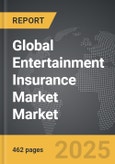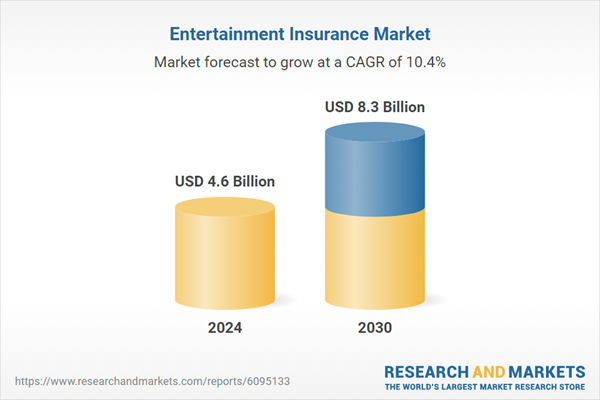Global Entertainment Insurance Market - Key Trends & Drivers Summarized
How Are Evolving Production Risks and Legal Complexities Shaping the Need for Specialized Insurance?
The landscape of entertainment production has grown increasingly complex with the rise of high-budget global content, multi-location shoots, celebrity-driven projects, and high-value live events. This complexity has led to a surge in demand for tailored entertainment insurance products designed to address highly specific exposures. From cast insurance and weather disruption coverage to intellectual property infringement and negative film risks, policies are now being crafted with deeper underwriting intelligence, factoring in geopolitical risk, cyber intrusion threats, and cross-border jurisdictional liabilities. Insurers are leveraging scenario modeling tools that assess production-specific vulnerabilities - such as filming delays due to visa issues, strikes, pandemics, or injuries to key cast members - which can derail multimillion-dollar projects.The legal environment surrounding entertainment production is also influencing insurance structures. The proliferation of content across OTT platforms, digital events, and social media has heightened the risk of defamation, libel, rights infringement, and moral clauses breaches. These concerns have pushed demand for Errors & Omissions (E&O) insurance, especially among digital creators, indie filmmakers, and branded content producers. Studios and streaming services are increasingly requiring E&O coverage as a contractual obligation before distribution, especially for projects involving complex licensing arrangements, archival footage, or unscripted formats. As legal compliance becomes intertwined with content delivery, insurance is no longer an auxiliary safeguard but a precondition to financial structuring and distribution planning in the entertainment value chain.
Why Are New Genres and Content Formats Demanding Customized Coverage Structures?
The emergence of new-age content formats such as immersive experiences, virtual concerts, metaverse events, and interactive live streams is expanding the scope of insurable risks in the entertainment sector. Traditional coverage templates are proving inadequate for these hybrid digital-physical models, prompting underwriters to develop new policy modules for data privacy, network downtime, real-time piracy, avatar infringement, and unauthorized AI-generated likenesses. Events hosted in virtual worlds often carry both technology-related and entertainment-specific risks, requiring coordination between cyber insurance, media liability, and general event coverage in a consolidated framework. Insurers are working with digital production teams to assess platform vulnerabilities, engagement metrics, and user behavior patterns before determining premiums.Esports is another domain where unique insurance requirements are emerging. Tournament organizers, venue operators, and talent management agencies are now seeking policies that address equipment damage, gameplay disruption, player injuries, sponsorship non-performance, and technical sabotage. As esports prize pools surge and media rights become more valuable, the need for business interruption insurance and contractual liability protection is rising in tandem. Additionally, intellectual property concerns related to game licensing, character usage, and cross-brand partnerships are requiring a nuanced insurance lens. The diversity in production environments - ranging from studio-based filming to remote live broadcasts in international locations - is also driving hybrid coverage solutions that accommodate multiple jurisdictions and risk environments within a single policy construct.
What Market Forces Are Reshaping Underwriting, Claims, and Distribution Models?
Digitization and data integration are transforming how entertainment insurance is underwritten, managed, and distributed. Insurtech players are entering the market with AI-powered platforms capable of analyzing production schedules, financial disclosures, shooting locations, weather data, and cast histories to offer near-instant quotes for specialized entertainment policies. Blockchain technologies are being explored to timestamp footage, verify licensing claims, and streamline payouts in the event of delays or content disputes. Automated claims processing with smart contracts is beginning to find traction in areas like event cancellation, where verifiable conditions such as venue closure or weather alerts can trigger instant disbursements.Meanwhile, the distribution of insurance is evolving from direct brokerage models to integrated platforms tied to production software, studio financial tools, and rights management systems. Major streaming studios and media conglomerates are now negotiating blanket insurance arrangements with carriers to cover annual content slates, thereby optimizing premiums and administrative overhead. The global nature of production has also created demand for multi-currency, multilingual insurance solutions that can be activated across diverse legal frameworks. Emerging players are developing bundled offerings that combine media liability, cyber coverage, and event protection into modular packages designed for creators and companies operating at different scale levels - from solo digital influencers to billion-dollar studio franchises.
What Is Fueling the Accelerated Demand in the Global Entertainment Insurance Market?
The growth in the entertainment insurance market is driven by several factors that span technological disruption, risk diversification, and new forms of media monetization. One of the primary growth drivers is the exponential increase in content production globally, spurred by the surge in demand from streaming platforms, short-form video apps, and immersive entertainment ecosystems. As production volumes grow, so too does the financial exposure of stakeholders - including investors, advertisers, distributors, and platforms - making insurance a central pillar in project viability assessments. The increasing reliance on bank financing and investor equity in content deals is making entertainment insurance an essential element in risk transfer and revenue assurance.Additionally, live events and festivals are witnessing a renaissance post-pandemic, further driving demand for cancellation, liability, and terrorism-related coverages. With audience expectations now elevated, organizers are investing in large-scale productions that involve complex logistics, celebrity participation, and international travel - each of which adds layers of insurable risk. Similarly, the return of major touring acts and international sporting tournaments has prompted a revival in multi-layered insurance programs involving event organizers, stadiums, sponsors, and local authorities. High-profile incidents of cancellations, crowd-related lawsuits, and technical failures have further elevated insurance from a best-practice measure to an operational necessity.
Finally, regulatory tightening and IP vigilance are contributing to market expansion. Governments and content platforms are imposing stricter policies around user-generated content, copyright compliance, and cross-border distribution - forcing creators to invest in broader E&O coverage. Simultaneously, growing awareness among digital-first content producers, influencer agencies, and VR/AR creators is expanding the addressable base for entertainment insurance. As content becomes more mobile, modular, and monetized, insurance providers that offer agility, digital integration, and bespoke policy structures are poised to capture rising demand across every segment of the entertainment industry.
Report Scope
The report analyzes the Entertainment Insurance market, presented in terms of market value (US$). The analysis covers the key segments and geographic regions outlined below:- Segments: Insurance (Production Insurance, Staging & Rigging Insurance, Special Event Insurance, Touring Insurance); Coverages (Liability Coverage, Commercial Property Coverages, Other Coverages); Distribution Channel (Brokers Distribution Channel, Non-Brokers Distribution Channel); End-Use (Business End-Use, Individuals End-Use).
- Geographic Regions/Countries: World; United States; Canada; Japan; China; Europe (France; Germany; Italy; United Kingdom; Spain; Russia; and Rest of Europe); Asia-Pacific (Australia; India; South Korea; and Rest of Asia-Pacific); Latin America (Argentina; Brazil; Mexico; and Rest of Latin America); Middle East (Iran; Israel; Saudi Arabia; United Arab Emirates; and Rest of Middle East); and Africa.
Key Insights:
- Market Growth: Understand the significant growth trajectory of the Production Insurance segment, which is expected to reach US$3.5 Billion by 2030 with a CAGR of a 11.7%. The Staging & Rigging Insurance segment is also set to grow at 10.7% CAGR over the analysis period.
- Regional Analysis: Gain insights into the U.S. market, valued at $1.2 Billion in 2024, and China, forecasted to grow at an impressive 14.3% CAGR to reach $1.7 Billion by 2030. Discover growth trends in other key regions, including Japan, Canada, Germany, and the Asia-Pacific.
Why You Should Buy This Report:
- Detailed Market Analysis: Access a thorough analysis of the Global Entertainment Insurance Market, covering all major geographic regions and market segments.
- Competitive Insights: Get an overview of the competitive landscape, including the market presence of major players across different geographies.
- Future Trends and Drivers: Understand the key trends and drivers shaping the future of the Global Entertainment Insurance Market.
- Actionable Insights: Benefit from actionable insights that can help you identify new revenue opportunities and make strategic business decisions.
Key Questions Answered:
- How is the Global Entertainment Insurance Market expected to evolve by 2030?
- What are the main drivers and restraints affecting the market?
- Which market segments will grow the most over the forecast period?
- How will market shares for different regions and segments change by 2030?
- Who are the leading players in the market, and what are their prospects?
Report Features:
- Comprehensive Market Data: Independent analysis of annual sales and market forecasts in US$ Million from 2024 to 2030.
- In-Depth Regional Analysis: Detailed insights into key markets, including the U.S., China, Japan, Canada, Europe, Asia-Pacific, Latin America, Middle East, and Africa.
- Company Profiles: Coverage of players such as Anschutz Entertainment Group (AEG), Bandai Namco Holdings Inc., Big Hit Entertainment (HYBE), Bolloré SE, Caesars Entertainment and more.
- Complimentary Updates: Receive free report updates for one year to keep you informed of the latest market developments.
Some of the 36 companies featured in this Entertainment Insurance market report include:
- Allen Financial Insurance Group
- Allianz SE
- American International Group (AIG)
- Aon plc
- Arch Capital Group Ltd.
- Athos Insurance Services
- AXA XL
- Beazley Group
- Brady Insurance
- Chubb Limited
- Everest Re Group, Ltd.
- Front Row Insurance Brokers Inc.
- Gallagher (Arthur J. Gallagher & Co.)
- Hiscox Ltd
- HUB International
- Insurance Canopy
- Markel Corporation
- MFE Insurance Brokerage
- Munich Re Group
- Next Insurance Inc.
This edition integrates the latest global trade and economic shifts into comprehensive market analysis. Key updates include:
- Tariff and Trade Impact: Insights into global tariff negotiations across 180+ countries, with analysis of supply chain turbulence, sourcing disruptions, and geographic realignment. Special focus on 2025 as a pivotal year for trade tensions, including updated perspectives on the Trump-era tariffs.
- Adjusted Forecasts and Analytics: Revised global and regional market forecasts through 2030, incorporating tariff effects, economic uncertainty, and structural changes in globalization. Includes historical analysis from 2015 to 2023.
- Strategic Market Dynamics: Evaluation of revised market prospects, regional outlooks, and key economic indicators such as population and urbanization trends.
- Innovation & Technology Trends: Latest developments in product and process innovation, emerging technologies, and key industry drivers shaping the competitive landscape.
- Competitive Intelligence: Updated global market share estimates for 2025, competitive positioning of major players (Strong/Active/Niche/Trivial), and refined focus on leading global brands and core players.
- Expert Insight & Commentary: Strategic analysis from economists, trade experts, and domain specialists to contextualize market shifts and identify emerging opportunities.
Table of Contents
Companies Mentioned (Partial List)
A selection of companies mentioned in this report includes, but is not limited to:
- Allen Financial Insurance Group
- Allianz SE
- American International Group (AIG)
- Aon plc
- Arch Capital Group Ltd.
- Athos Insurance Services
- AXA XL
- Beazley Group
- Brady Insurance
- Chubb Limited
- Everest Re Group, Ltd.
- Front Row Insurance Brokers Inc.
- Gallagher (Arthur J. Gallagher & Co.)
- Hiscox Ltd
- HUB International
- Insurance Canopy
- Markel Corporation
- MFE Insurance Brokerage
- Munich Re Group
- Next Insurance Inc.
Table Information
| Report Attribute | Details |
|---|---|
| No. of Pages | 462 |
| Published | December 2025 |
| Forecast Period | 2024 - 2030 |
| Estimated Market Value ( USD | $ 4.6 Billion |
| Forecasted Market Value ( USD | $ 8.3 Billion |
| Compound Annual Growth Rate | 10.4% |
| Regions Covered | Global |









